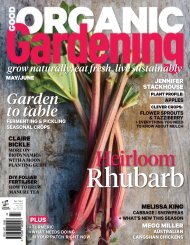1. Good Organic Gardening - January-February 2016
1. Good Organic Gardening - January-February 2016
1. Good Organic Gardening - January-February 2016
You also want an ePaper? Increase the reach of your titles
YUMPU automatically turns print PDFs into web optimized ePapers that Google loves.
Danny Summers | GARDENING FOLK<br />
Danny hosts seven honeybee<br />
hives for a friend<br />
Danny grows a great selection of fruit trees and shrubs, including<br />
pomegranate, passionfruit, Brazilian guavas, boysenberries, peaches,<br />
oranges, limes and lemonades, as well as native hibiscus.<br />
Words & photos Sandra Tuszynska<br />
Danny and his wife Carolyn have<br />
lived near Murgon in southeast<br />
Queensland for the past 15<br />
years. Both have a passion for<br />
art; while Carolyn loves to draw and paint,<br />
Danny creates installations for the garden<br />
using recycled materials. He especially loves<br />
to collect old electricity post insulators and<br />
install them as garden décor.<br />
Danny feels sentimental about burning<br />
the 100-year old timber. “It’s too sad to<br />
burn history,” he says. He’s fascinated by<br />
the antique ceramic insulators and says the<br />
workmanship in them is incredible: “They look<br />
as good as new.” He jokes, “I wish I looked as<br />
good at 60 years old.”<br />
For the love of bees<br />
Danny hesitates to admit that bees<br />
are his passion, but he’s a dedicated<br />
member of Valley Bees, a very active and<br />
knowledgeable bee group based in Gympie.<br />
He hosts seven honeybee hives for a friend<br />
and rescues native bee hives. Danny finds<br />
out about selective clearing events and<br />
goes there beforehand to inspect the site<br />
for native bee activity. He then removes any<br />
logs inhabited by the tiny creatures and<br />
takes them home.<br />
Danny doesn’t collect their honey; he<br />
just loves them and likes to use their log<br />
homes as installations for his garden. He<br />
estimates that around 10 resued colonies<br />
now have their homes on his property.<br />
“You need to know when to rescue them,”<br />
he explains. “They increase their activity<br />
when it’s hot. Water is essential for bees and<br />
they’re sensitive to disturbance. Also, if<br />
you leave space for them in the log, the<br />
hive will grow.”<br />
We have about 10 species of native<br />
social bees in the genera Tetragonula<br />
and Austroplebeia.<br />
Danny has also created several bee<br />
blocks for solitary native bees on old<br />
electricity poles with insulators. Plus, he<br />
The filled holes indicate occupation<br />
by native bees<br />
has built a bee wall near his gardens to<br />
provide a nesting habitat for the myriad<br />
solitary bees that live in the area.<br />
He explains, “Different hole sizes are<br />
used by different bee species, which use<br />
different materials for their nests and to<br />
block off their nests, so you can tell which<br />
species of bees are using the sites.”<br />
Many of the holes in the wooden blocks<br />
are filled, a good indication that bees or<br />
other creatures are making use of the<br />
nesting sites. The bee haven Danny has<br />
created seems to be appreciated by the<br />
various pollinators that inhabit his garden.<br />
<strong>Good</strong> <strong>Organic</strong> <strong>Gardening</strong> | 31
















